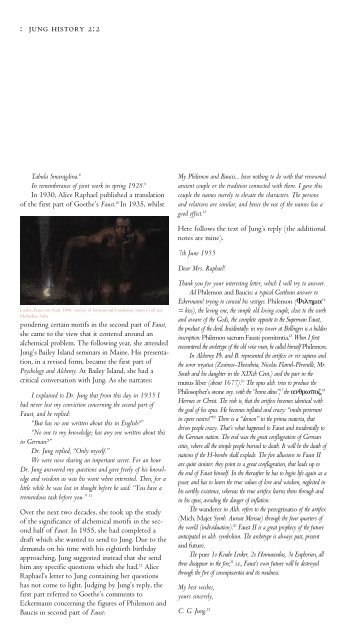a semi-annual publication of the philem n foundation - Philemon ...
a semi-annual publication of the philem n foundation - Philemon ...
a semi-annual publication of the philem n foundation - Philemon ...
You also want an ePaper? Increase the reach of your titles
YUMPU automatically turns print PDFs into web optimized ePapers that Google loves.
: jung history 2:2<br />
Tabula Smaragdina. 8<br />
In rememberance <strong>of</strong> joint work in spring 1928. 9<br />
In 1930, Alice Raphael published a translation<br />
<strong>of</strong> <strong>the</strong> first part <strong>of</strong> Goe<strong>the</strong>’s Faust. 10 In 1935, whilst<br />
Lucifer, Franz von Stuck, 1890, courtesy <strong>of</strong> International Foundation, Saints Cyrill and<br />
Methodius, S<strong>of</strong>ia<br />
pondering certain motifs in <strong>the</strong> second part <strong>of</strong> Faust,<br />
she came to <strong>the</strong> view that it centered around an<br />
alchemical problem. The following year, she attended<br />
Jung’s Bailey Island <strong>semi</strong>nars in Maine. His presentation,<br />
in a revised form, became <strong>the</strong> first part <strong>of</strong><br />
Psychology and Alchemy. At Bailey Island, she had a<br />
critical conversation with Jung. As she narrates:<br />
I explained to Dr. Jung that from this day in 1935 I<br />
had never lost my conviction concerning <strong>the</strong> second part <strong>of</strong><br />
Faust, and he replied:<br />
“But has no one written about this in English?”<br />
“No one to my knowledge; has any one written about this<br />
in German?”<br />
Dr. Jung replied, “Only myself.”<br />
We were now sharing an important secret. For an hour<br />
Dr. Jung answered my questions and gave freely <strong>of</strong> his knowledge<br />
and wisdom as was his wont when interested. Then, for a<br />
little while he was lost in thought before he said: “You have a<br />
tremendous task before you.” 11<br />
Over <strong>the</strong> next two decades, she took up <strong>the</strong> study<br />
<strong>of</strong> <strong>the</strong> significance <strong>of</strong> alchemical motifs in <strong>the</strong> second<br />
half <strong>of</strong> Faust. In 1955, she had completed a<br />
draft which she wanted to send to Jung. Due to <strong>the</strong><br />
demands on his time with his eightieth birthday<br />
approaching, Jung suggested instead that she send<br />
him any specific questions which she had. 12 Alice<br />
Raphael’s letter to Jung containing her questions<br />
has not come to light. Judging by Jung’s reply, <strong>the</strong><br />
first part referred to Goe<strong>the</strong>’s comments to<br />
Eckermann concerning <strong>the</strong> figures <strong>of</strong> <strong>Philemon</strong> and<br />
Baucis in second part <strong>of</strong> Faust:<br />
My <strong>Philemon</strong> and Baucis... have nothing to do with that renowned<br />
ancient couple or <strong>the</strong> tradition connected with <strong>the</strong>m. I gave this<br />
couple <strong>the</strong> names merely to elevate <strong>the</strong> characters. The persons<br />
and relations are similar, and hence <strong>the</strong> use <strong>of</strong> <strong>the</strong> names has a<br />
good effect. 13<br />
Here follows <strong>the</strong> text <strong>of</strong> Jung’s reply (<strong>the</strong> additional<br />
notes are mine).<br />
7th June 1955<br />
Dear Mrs. Raphael!<br />
Thank you for your interesting letter, which I will try to answer.<br />
Ad <strong>Philemon</strong> and Baucis: a typical Goe<strong>the</strong>an answer to<br />
Eckermann! trying to conceal his vestiges. <strong>Philemon</strong> (������ 14<br />
= kiss), <strong>the</strong> loving one, <strong>the</strong> simple old loving couple, close to <strong>the</strong> earth<br />
and aware <strong>of</strong> <strong>the</strong> Gods, <strong>the</strong> complete opposite to <strong>the</strong> Superman Faust,<br />
<strong>the</strong> product <strong>of</strong> <strong>the</strong> devil. Incidentally: in my tower at Bollingen is a hidden<br />
inscription: <strong>Philemon</strong> sacrum Fausti poenitentia. 15 When I first<br />
encountered <strong>the</strong> archetype <strong>of</strong> <strong>the</strong> old wise man, he called himself <strong>Philemon</strong>.<br />
In Alchemy Ph. and B. represented <strong>the</strong> artifex or vir sapiens and<br />
<strong>the</strong> soror mystica (Zosimos-Theosebeia, Nicolas Flamel-Péronelle, Mr.<br />
South and his daughter in <strong>the</strong> XIXth Cent.) and <strong>the</strong> pair in <strong>the</strong><br />
mutus liber (about 1677). 16 The opus alch. tries to produce <strong>the</strong><br />
Philosopher’s stone sny. with <strong>the</strong> “homo altus”, 17 <strong>the</strong> ��������, 18<br />
Hermes or Christ. The risk is, that <strong>the</strong> artifex becomes identical with<br />
<strong>the</strong> goal <strong>of</strong> his opus. He becomes inflated and crazy: “multi perierunt<br />
in opere nostro!” 19 There is a “demon” in <strong>the</strong> prima materia, that<br />
drives people crazy. That’s what happened to Faust and incidentally to<br />
<strong>the</strong> German nation. The end was <strong>the</strong> great conflagration <strong>of</strong> German<br />
cities, where all <strong>the</strong> simple people burned to death. It will be <strong>the</strong> death <strong>of</strong><br />
nations if <strong>the</strong> H-bombs shall explode. The fire allusions in Faust II<br />
are quite sinister: <strong>the</strong>y point to a great conflagration, that leads up to<br />
<strong>the</strong> end <strong>of</strong> Faust himself. In <strong>the</strong> <strong>the</strong>reafter he has to begin life again as a<br />
puer and has to learn <strong>the</strong> true values <strong>of</strong> love and wisdom, neglected in<br />
his earthly existence, whereas <strong>the</strong> true artifex learns <strong>the</strong>m through and<br />
in his opus, avoiding <strong>the</strong> danger <strong>of</strong> inflation.<br />
The wanderer in Alch. refers to <strong>the</strong> peregrinatio <strong>of</strong> <strong>the</strong> artifex<br />
(Mich. Majer Symb. Aureae Mensae) through <strong>the</strong> four quarters <strong>of</strong><br />
<strong>the</strong> world (individuation). 20 Faust II is a great prophecy <strong>of</strong> <strong>the</strong> future<br />
anticipated in alch. symbolism. The archetype is always past, present<br />
and future.<br />
The puer 1o Knabe Lenker, 2o Homunculus, 3o Euphorion, all<br />
three disappear in <strong>the</strong> fire, 21 i.e., Faust’s own future will be destroyed<br />
through <strong>the</strong> fire <strong>of</strong> concupiscentia and its madness.<br />
My best wishes,<br />
yours sincerely,<br />
C. G. Jung. 22


